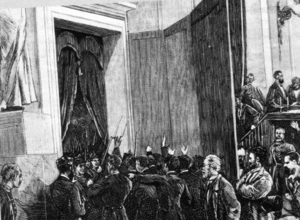Coup d'état of Pavía facts for kids

Illustration of Pavia's troops entering the Congress of Deputies
|
|
| Native name | Golpe de Estado de Pavía |
|---|---|
| Date | January 3, 1874 |
| Location | Congress of Deputies, Madrid, Spain |
| Type | Coup d'état |
The Coup d'état of Pavía (which means Pavía's Coup in Spanish) was a sudden takeover of the government. It happened on January 3, 1874, in Spain. General Manuel Pavía y Rodríguez de Alburquerque led this military action.
This event changed Spain from a democratic government to one controlled by the military. It marked a big shift during the time of the First Spanish Republic.
What Led to the Coup?
Spain became a republic in February 1873. This was a time of many changes and problems in Spanish history. It was called the Sexenio Democrático, or "Democratic Six Years."
Spain's parliament, called the Cortes Generales, faced many disagreements. Different political groups could not agree on how to run the country. These groups included moderates, centrists, and those with very strong views.
Many people in the Cortes worried about national unity. Spain was dealing with two major uprisings at the same time. In the north, there was the Third Carlist War, a conservative revolt. In the south, there was the Cantonal rebellion, a socialist uprising.
Emilio Castelar was the President of the Executive Power. He was a moderate politician. To gain more control over the military, he temporarily closed the Cortes in September 1873. As the problems worsened, Castelar asked the Cortes to meet again. He hoped they would give him more power to handle the crises.
The Coup Happens
General Pavía supported President Castelar. On January 2, he placed his troops near the Congress of Deputies building in Madrid. This was where the parliament members were meeting.
Early on January 3, a vote took place. This was a "vote of confidence" to see if Castelar's government still had enough support. Castelar's government lost the vote.
Then, a new vote began to choose a new President. It looked like a group of radical politicians might win. General Pavía then ordered his soldiers to surround the Cortes building. He demanded that the meeting be stopped.
The former president, Nicolás Salmerón y Alonso, was leading the vote. He and other members stayed inside. But Pavía's forces entered the building. By 6:55 AM, all the members were out of the building. No one was hurt.
Pavía offered the presidency back to Castelar. But Castelar refused because of how the military had taken over. Instead, Pavía found Francisco Serrano. Serrano had been living in France. He did not support the republic. Serrano officially closed the Cortes on January 8, 1874.
What Happened Next?
General Pavía's coup on January 3 effectively ended the Spanish Republic. Even though it was still called a republic for a while, the military was really in charge.
Serrano led a military government. During this time, any opposition was stopped. The republic officially ended on December 29, 1874. At that time, the Bourbon monarchy was peacefully brought back to Spain.
See also
 In Spanish: Golpe de Estado de Pavía para niños
In Spanish: Golpe de Estado de Pavía para niños

